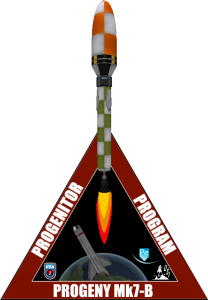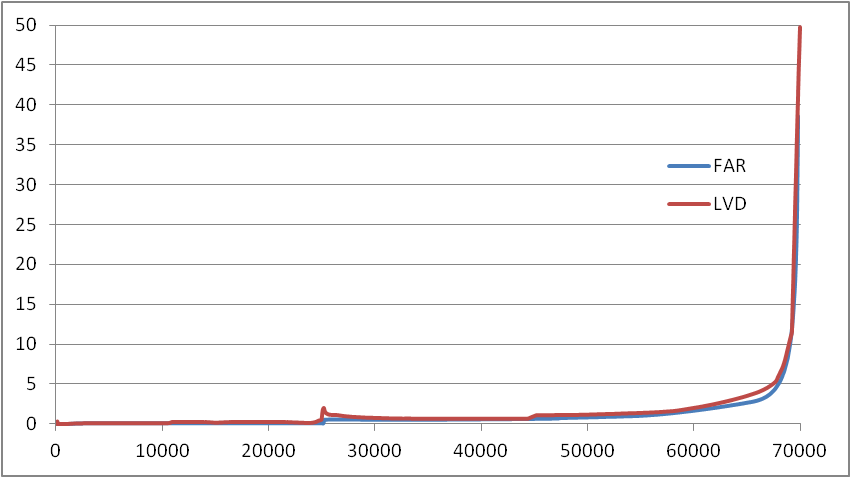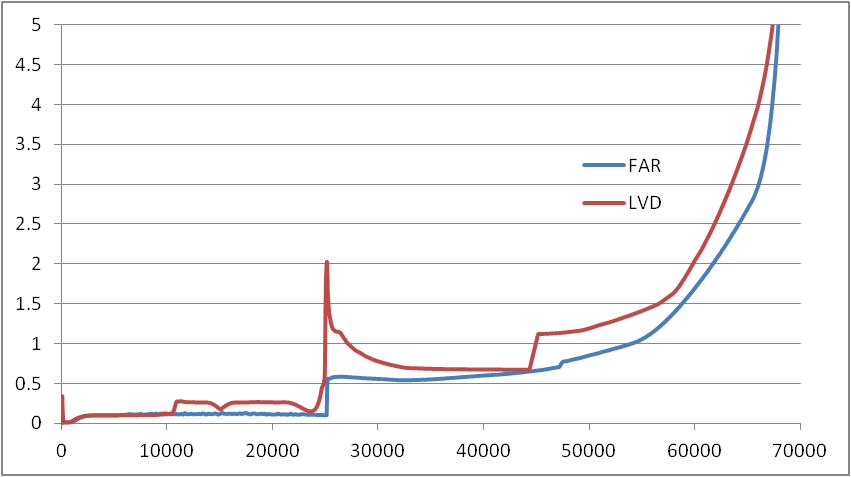 Originally announced back in late 2019, the Mk7-B was meant to fly earlier this year however the bankruptcy of Umbra Space Industries and the following litigation led to the suspension of Progeny launches that lasted several months on top of the self-imposed general launch suspension earlier in the year. Finally, nearly a year after the last Progeny Mk7-A flight the Mk7-B conducted its first mission.
Originally announced back in late 2019, the Mk7-B was meant to fly earlier this year however the bankruptcy of Umbra Space Industries and the following litigation led to the suspension of Progeny launches that lasted several months on top of the self-imposed general launch suspension earlier in the year. Finally, nearly a year after the last Progeny Mk7-A flight the Mk7-B conducted its first mission.
Leading up to the launch, the rocket was carefully checked out after having sat around for months since finishing assembly earlier in the year. Rollout to the launch pad was initially delayed due to mechanical problems with the carry vehicle and once out on the pad despite a good wet dress rehearsal additional delays were required thanks to some launch system upgrades that were made during the downtime between this and the previous unkerbed launch.
Two days after the new launch date operations were finally allowed to proceed in preparing the rocket for lift off. Pre-launch protocols went smoothly and weather was cooperative throughout.
The Flight
At L-2 minutes the terminal count procedures began with the AFCS taking command of the rocket as the service tower swung away to leave the spacecraft on internal power and radio comms. Leading up to the final T-30s polls battery drain rates were monitored and signal checks undertaken. With all systems GO, the rocket proceeded with final launch procedures and the support legs keeping it stable against any sudden wind gusts were retracted 5s prior to T-0.
Support legs out of the way, the rocket was cleared to ignite its dual-segment lower-stage Boostertron II solid rocket motor and shoot up off the engine clamp with an initial TWR of 3 at precisely 13:30:00.04 local time. The guidance program kicked in 32ms later to begin flying the programmed pitch profile that would send it downrange, heading direct east. The rocket was already facing this direction so no yaw/roll correction was needed off the pad.
Thrust from the lower stage peaked 5s after launch at 74kN before starting to slowly fall off so the rocket would continue to accelerate up through the thick air of the lower atmosphere but not dangerously so. Already traveling over 100m/s dynamic pressure was quickly starting to build and at L+14s passed 40kPa and into the “warning” range of excessively high pressure. The rocket went supersonic shortly afterward at L+16s and MaxQ came at L+20s with 51.21kPa @ 4.486km. This was below the max calculated rating of 60kPa but closer to it than we would have liked.
Shortly after pushing through Max Q, at L+23s, the rocket became highly unstable – to the point where Lead Engineer Simon called it “wibbly wobbly”. Large control corrections were needed to keep it anywhere close to on course and everyone watching the tracking camera footage were worried the rocket would literally shake itself apart. Somehow it managed to hold together, appearing to lose half of its second stage engine fairing, and the booster cut off came at L+46s when all solid propellants were expended.
As the rocket coasted up to 25km its speed dropped and control inputs thankfully stabilized. This meant that staging at L+ 1m9s occurred without issue, the lower booster falling away with its parachutes armed as the upper stage Ospray liquid fuel engine ignited to continue the push towards space at 13kN (2 TWR). Thrust vector control was able to keep the rocket on course and following the pitch profile.
At L+1m52s the engine was cut off by the flight computer at only 46km (planned MECO-1 was 70km) because otherwise there would not have been enough fuel remaining to do a restart in space due to lack of tank pressure. The computer also made sure however that the rocket would actually reach space before triggering MECO-1, even if it would only be ~80km initially. The reaction wheel system was brought online to hold the nose prograde as the rocket continued up out of the atmosphere, able to be used thanks to the rapidly thinning air.
Leaving the atmosphere behind at L+2m37s flight controllers ran some checks on the engine and propellant system to get data on the pre-start conditions before sending up the command to re-ignite the Ospray at L+2m54s, which was successfully carried out for a 12s burn that pushed the rocket’s apokee up to 84km, which it reached shortly afterwards at L+3m50s.
Once through apokee the command was sent to re-orient the rocket retrograde for re-entry. The reaction wheel system struggled to do this on a previous Mk7-A mission when the entire upper stage was attached, but since then improvements have been made to the power management and although it took 20s the rocket was able to smoothly rotate around to face backwards without any trouble finding the proper orientation along the way. There was not enough time for any additional or extensive testing of the reaction wheel system as planned.
Re-entry began at L+4m59s with the rocket hitting the top of the atmosphere traveling at 932m/s, which would eventually climb to just over 1km/s. Heat from air friction built up a plasma wall around the rocket that cut off communication with KSC at L+5m31s. Communication was not restored before the rocket fell below the horizon. 15s after comm blackout stress on the rocket caused the lower half of the fuel tank to separate, taking the engine with it and ripping up vital sensor lines that crashed the flight computer. The parachute was already armed however and deployed properly to bring the remains of the rocket down to the Kerblantic intact roughly 200km downrange.
Flight Analysis
Early Ascent Instability
During the first stage booster flight shortly after passing through Max Q the rocket began to experience an effect known from the Ascension program as “roll-shake“, which has plagued our guidance control system for years. We did not expect the Mk7-B to suffer as bad as it did, as previous flights of the Mk7-A only showed minor roll-shaking occurring as the rocket passed through Mach 1.4. In the case of the Mk7-B however due to the more powerful and longer-burning lower stage the rocket was able to spend more time within the 1.4+ supersonic regime to really build up a bad case of oscillation response in the guidance control. The wobble of the rocket largely ceased as speeds decreased to below Mach 1.3 towards the end of the coast up to 25km.
Engine Shroud Failure
Half of the fairing that surrounds the 2nd stage engine and supports the link between the first and second stages became partially detached during the initial ascent, before even the violent roll shaking really kicked in. The fact that the rocket held together with a good portion of its structural support no longer doing its job is testament to the overall engineering, and while we are unsure if the fairing completely separated and fell away during the roll-shake we suspect that it managed to lodge itself just right to still help support the flight loads.
Why it happened so early in flight is a question Lead Engineer Simon and his team have attempted to answer, and their best guess is the long-term horizontal storage of the rocket while it awaited flight was to blame. While we always have periods during assembly where our rockets are oriented horizontally, none have ever stayed so for more than a few days prior to launch (although there have been long delays in Ascension launches, they are stored vertically). The supports on the rocket were not adequate to maintain proper lateral loading over time, which likely stressed out the engine shrouds and caused one of them to fail.
Poor Flight Performance
The rocket failed to reach near the planned velocity and altitude leading up to BECO, and in turn failed to achieve the apokee height and downrange travel we had expected from the Launch Vehicle Designer simulation. The error margins were large enough to suspect something wrong with the simulation software itself and an investigation into the matter remains ongoing.
Another suspect for the lack of performance was drag losses from the amount of roll-shake however it turns out the rocket’s ascent was way more efficient drag-wise than anticipated. You can see the wiggles denoting the period of instability but overall compared to the Mk7-A flight (from which the planned drag data was based on) the Mk7-B made a much cleaner ascent. This was in part due to the change in ascent profile allowing it to remain closer to prograde and reduce its angle of attack.
Reaction Wheel System Improvements
While there was not much time in space to run the reaction wheel system through its paces, the one transition it made from prograde all the way around to retrograde showed a lot of promise. The system properly identified the mass of the vehicle compared to the torque of its wheels and modulated power output so as to not overdraw the batteries. This meant the system was no longer running out of power and rebooting constantly, which would throw off its adjustments and cause it to constantly over-correct to miss pointing where it was commanded to.
Re-Entry Breakup
Post-flight inspection of the fuel tank’s remaining upper half revealed obvious stress fractures and analysis of the telemetry data shows that the rocket was coming in rather flat instead of engine-down directly towards the velocity vector. This put more lateral strain on the rocket and combined with the violence it endured on the ascent a structural failure is not too surprising. While it’s still good that we recovered the majority of the rocket, including all the parts that can be re-used, the loss of the engine was the single point of failure in the mission and will prevent us from learning more about how the thrust vector control system fared during ascent, which is important in future re-use and long-term missions.
The breakup also severed vital sensor wiring that interrupted execution of the flight computer. Thankfully chutes are armed prior to atmospheric entry and the built-in pressure sensor enabled deployment for a safe splashdown of what remained of the rocket.
First Stage Booster Recovery
Splashing down 9.6km off shore at 3m/s the booster was successfully recovered, towed back to shore, stripped to its core in the VAB then loaded up for transport so it could be shipped back to Periapsis Co. They have already gotten back to us with their initial assessment and it is positive. The booster was designed to withstand the salt water immersion and engineers there are expected to get to work over the next month on refurbishing it and recasting it with solid propellant.
Future Plans
One of the major changes to the next Progeny Mk7-B that thankfully did not require any launch delays was to adjust the authority limits on the guidance fins as well as constrain their motion in regards to certain axis of movement. The horizontal fins will only be used for pitch and a little roll, while the vertical fins will only be used for a little bit of yaw and roll. Since the rocket is already facing its flight direction only minor corrections in roll & yaw will be needed to stay on course. The pitch movement now has much less travel range compared to an Ascension rocket because the first stage will not be traveling high enough to experience thin air that would require larger amounts of deflection. While we don’t expect this to eliminate roll-shake, it should greatly reduce it and thus prevent structural damage to the rocket that could compromise an off-nominal re-entry.
Another change made was to reinforce the engine shroud to keep it in place and properly supporting the second stage, again to reduce stress on the fuel tanks and give the rocket a better chance at surviving re-entry should it again come down more sideways than vertical. Whether the shroud on the following two flights is also reinforced has still not been decided. More testing is being done to ascertain for sure that the long-term horizontal storage was the issue and if so it should not be a problem for the final two missions in October
We will continue to work with the LVD developer to figure out exactly how the simulation is lacking in regards to thrust output but in the meantime this next mission will not require any detailed modeling as it will be flown similar to this one.
Additional fault tolerance has been added to the flight computer so that it has a lesser chance of halting execution on RUD. While this is not the first time a rocket has broken apart during automated flight, we are still learning ways in which the automated system can be broken by unforeseen events.
Depending on how the initial ascent goes, we may hot stage on this next flight so we do not lose velocity in the coast up to 25km. We know that the Mk7-A was unable to maintain attitude and broke apart under high dynamic pressure on its first flight, but the staging point for the Mk7-B has the rocket traveling higher and slower. It’s feasible that without large amounts of roll-shake at BECO the upper stage should be able to maintain stable flight. Staying fast and getting higher will allow for more time to run the reaction wheel system through its paces and even losing the rocket will still give us valuable performance data.









